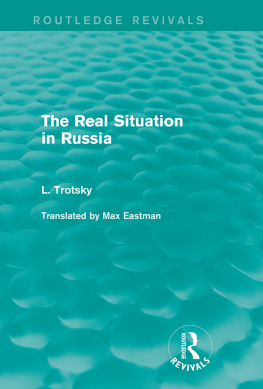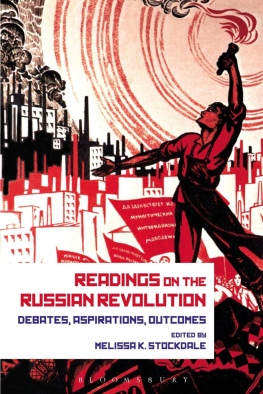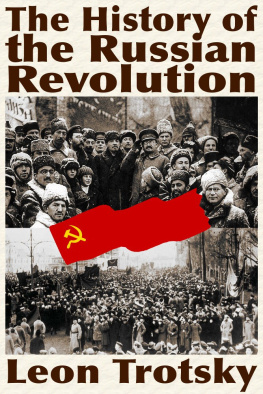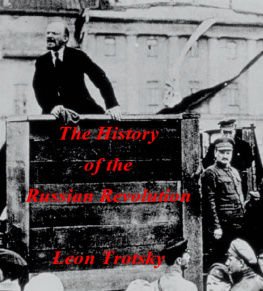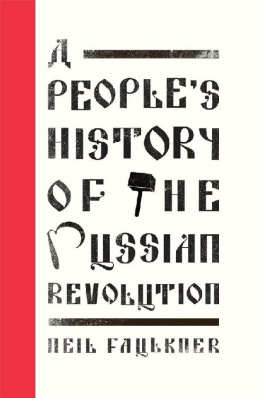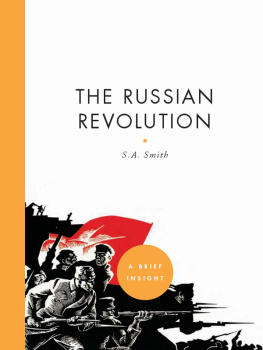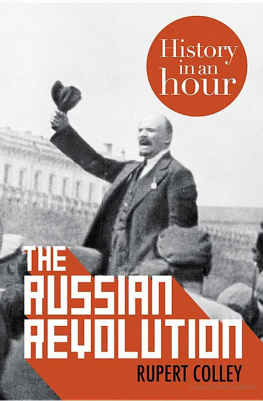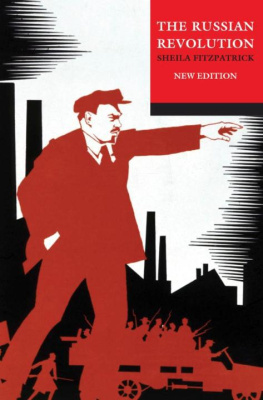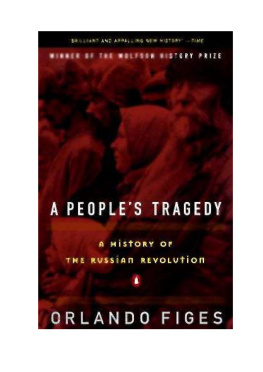Contents
Leon Trotsky
HISTORY OF THE RUSSIAN REVOLUTION
TRANSLATED BY MAX EASTMAN
PENGUIN CLASSICS
UK | USA | Canada | Ireland | Australia
India | New Zealand |South Africa
Penguin Books is part of the Penguin Random House group of companies whose addresses can be found at global.penguinrandomhouse.com.
First published 1932
Published in Penguin Classics 2017
Copyright 1932 Max Eastman, renewed 1961 (now held by Yvette Eastman)
Cover illustration: Celebration of May 1, 1920 by D. Menshikov. Sputnik/Topfoto.co.uk
ISBN: 978-0-241-30132-6
THE BEGINNING
Let the conversation begin
Follow the Penguin Twitter.com@penguinUKbooks
Keep up-to-date with all our stories YouTube.com/penguinbooks
Pin Penguin Books to your Pinterest
Like Penguin Books on Facebook.com/penguinbooks
Listen to Penguin at SoundCloud.com/penguin-books
Find out more about the author and
discover more stories like this at Penguin.co.uk
Introduction to Volumes Two and Three
Russia was so late in accomplishing her bourgeois revolution that she found herself compelled to turn it into a proletarian revolution. Or, in other words: Russia was so far behind the other countries that she was compelled, at least in certain spheres, to outstrip them. That seems inconsistent, but history is full of such paradoxes. Capitalist England was so far in advance of other countries that she had to trail behind them. Pedants think that the dialectic is an idle play of the mind. In reality it only reproduces the process of evolution, which lives and moves by way of contradictions.
The first volume of this work should have explained why that historically belated democratic regime which replaced tsarism proved wholly unviable. The present volumes are devoted to the coming to power of the Bolsheviks. Here too the fundamental thing is the narrative. In the facts themselves the reader ought to find sufficient support for the inferences.
By this the author does not mean to say that he has avoided sociological generalizations. History would have no value if it taught us nothing. The mighty design of the Russian Revolution, the consecutiveness of its stages, the inexorable pressure of the masses, the finishedness of political groupings, the succinctness of slogans, all this wonderfully promotes the understanding of revolution in general, and therewith of human society. For we may consider it proven by the whole course of history that society, torn as it is by inner contradictions, conclusively reveals in a revolution not only its anatomy, but also its soul.
In a more immediate manner, the present work should promote an understanding of the character of the Soviet Union. The timeliness of our theme lies not only in that the October Revolution took place before the eyes of a generation still livingalthough that of course has no small significancebut in the fact that the regime which issued from the revolution still lives and develops, and is confronting humanity with ever new riddles. Throughout the whole world the question of the soviet country is never lost sight of for a moment. However, it is impossible to understand any existent thing without a preliminary examination of its origin. For large-scale political appraisals, an historic perspective is essential.
The eight months of the revolution, February to October 1917, have required three volumes. The critics, as a general rule, have not accused us of prolixity. The scale of the work is explained rather by our approach to the material. You can present a photograph of a hand on one page, but it requires a volume to present the results of a microscopic investigation of its tissues. The author has no illusion as to the fullness or finishedness of his investigation. But nevertheless in many cases he was obliged to employ methods closer to the microscope than the camera.
At times, when it seemed to us that we were abusing the patience of the reader, we generously crossed out the testimony of some witness, the confession of a participant, or some secondary episode, but we afterward not infrequently restored much that had been crossed out. In this struggle for details, we were guided by a desire to reveal as concretely as possible the very process of the revolution. In particular it was impossible not to try to make the most of the opportunity to paint history from the life.
Thousands and thousands of books are thrown on the market every year presenting some new variant of the personal romance, some tale of the vacillations of the melancholic or the career of the ambitious. The heroine of Proust requires several finely-wrought pages in order to feel that she does not feel anything. It would seem that one might, at least with equal justice, demand attention to a series of collective historic dramas which lifted hundreds of millions of human beings out of nonexistence, transforming the character of nations and intruding forever into the life of all mankind.
The accuracy of our references and quotations in the first volume no one has so far called in question: that would indeed be difficult. Our opponents confine themselves for the most part to reflections upon the topic of how personal prejudice may reveal itself in an artificial and one-sided selection of facts and texts. These observations, although irrefutable in themselves, say nothing about the given work, and still less about its scientific methods. Moreover we take the liberty to insist firmly that the coefficient of subjectivism is defined, limited, and tested not so much by the temperament of the historian, as by the nature of his method.
The purely psychological school, which looks upon the tissue of events as an interweaving of the free activities of separate individuals or their groupings, offers, even with the best intentions on the part of the investigator, a colossal scope to caprice. The materialist method disciplines the historian, compelling him to take his departure from the weighty facts of the social structure. For us, the fundamental forces of the historic process are classes; political parties rest upon them; ideas and slogans emerge as the small change of objective interests. The whole course of the investigation proceeds from the objective to the subjective, from the social to the individual, from the fundamental to the incidental. This sets a rigid limit to the personal whims of the author.
When a mining engineer finds magnetic ore in an uninvestigated region by drilling, it is always possible to assume that this was a happy accident: the construction of a mine is hardly to be recommended. But when the same engineer, on the basis, let us say, of the deviation of a magnetic needle, comes to the conclusion that a vein of ore lies concealed in the earth, and subsequently actually strikes ore at various different points in the region, then the most caviling skeptic will not venture to talk about accidents. What convinces is the system that unites the general with the particular.


